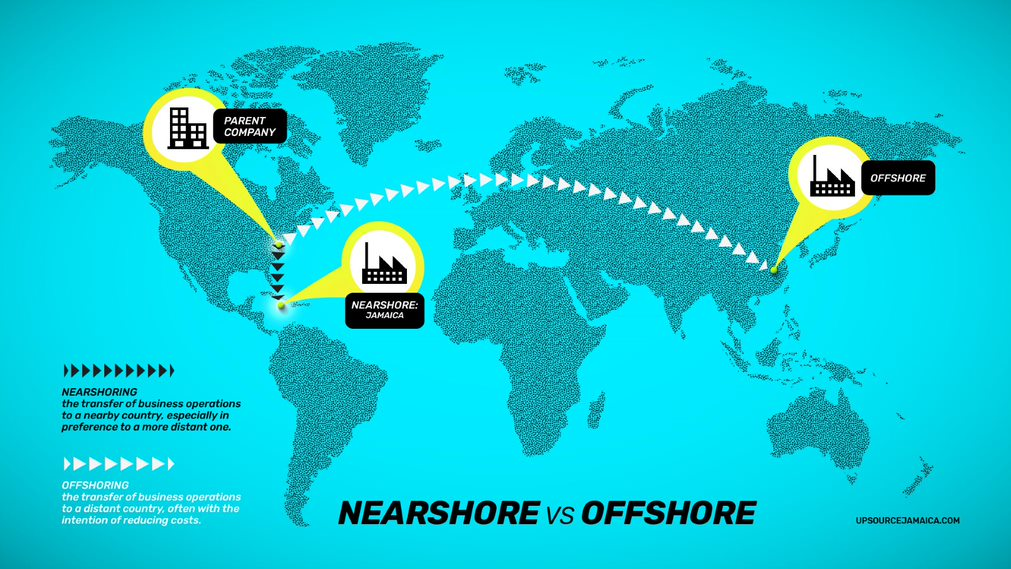In an ever-evolving global marketplace, businesses are constantly seeking ways to enhance efficiency, reduce costs, and focus on core functions. Nearshoring or offshoring could be viable business solutions. In this blog, we explore the major pros and cons with either approach to help you make an informed decision for your business
Understanding Nearshoring and Offshoring
Both nearshoring and offshoring involve outsourcing parts of your operational activities to another country. According to research done by Zippia, 66% of businesses in the United States outsource at least one of their departments. Offshoring, sometimes referred to as farshoring, involves moving operations to a distant country or continent, often with the intention of reducing costs. Nearshoring on the other hand involves moving operations to a nearby country, especially in preference to a more distant one. There are several factors that can lead a company to explore nearshoring or offshoring options. Considering how well these needs are met by either approach, can help you determine which one is the better fit for your business.
Talent Pool & Quality
In the Deloitte Global Outsourcing Survey (2022), 50% of executives identified talent acquisition as a top internal challenge in meeting their organisation’s strategic priorities. If you are unable to source needed expertise at home (or in the numbers you need), setting up operations in a locale where such talent is readily available can be a major boost to your business. You can access larger talent pools with diverse competencies with either nearshoring or offshoring strategies. In the Tech industry for instance, companies in The Americas often look to distant countries like India when seeking large pools of highly qualified talent. Of course, Latin America and The Caribbean are proving just as capable of providing quality IT services as well as business processing and knowledge processing services.
Communication & Collaboration
Managing teams across various locations can be difficult. However, managing teams in different countries or across continents with major time differences, language barriers and cultural differences can be a nightmare for the uninitiated, hampering collaboration and communication. With nearshoring, it’s possible to source talent in similar time zones who also speak the same language and share key cultural similarities. Meanwhile, offshoring can present severe challenges on this front. Take for instance teams where some members in one location are clocking out when other team members in the offshore location are just waking up. Scheduling conflicts can quickly arise when there are such major time differences.
Cost Considerations
In the Deloitte Global Outsourcing Survey it was found that reduction of costs was the primary reason for traditional outsourcing. While it is possible to find nearby countries where savings can be realised, offshoring is especially popular because of the ability to substantially reduce labour costs, material costs, and other overhead costs such as rental of equipment and office space. With offshoring, it’s possible to access top tier talent all while operating at a fraction of the cost of doing so in your home country. Cost considerations alone often induce executives in The Americas to look farther afield to countries like India, China, the Philippines, and parts of Europe.
Regional Realities
Operating in foreign locations can also mean longer shipping and delivery times for your finished products or resources – the further away, the longer those times may be. Furthermore, political tensions, armed conflict, and economic uncertainty in some regions of the world can present another level of risk for your operations. 
Countries like Jamaica have become favourites among Fortune 500 companies in The Americas who have opted to go the route of nearshoring. These companies have gained access to large pools of highly skilled, English-speaking workers who work in a similar time zone. This makes communication and collaboration across teams much easier with less confusion when synchronising schedules. It’s also easier to make regular and frequent onsite visits to speedily respond to emergencies and maintain greater oversight of overseas operations. Along with 100 Special Economic Zones, Jamaica also offers considerable tax and regulatory incentives. With a labour force of 1.3 million, the country was named the #1 country in the Caribbean with which to do business by Forbes and the World Bank in 2019. Also in 2019, Jamaica was ranked the 6th easiest place to start a business by the World Bank and ranked as the country with the 6th least red tape by Forbes.
Choosing the best strategy for your business
To determine the best strategy for your business, critical factors such as budget considerations, time zone differences, and language barriers must be evaluated. If cost reduction is paramount to your operations, then offshoring is a viable option. However, if real-time collaboration and communication are crucial to your success, nearshoring may be the better fit.
Regardless of the chosen approach, creating a well-thought-out nearshoring or offshoring strategy is crucial. It should reflect strict compliance with the country’s labour laws; adoption and maintenance of best practices; sensitivity to the culture; fair and transparent hiring practices; and well thought out managerial policies aimed at creating synergies between the overseas operations and the parent company.










